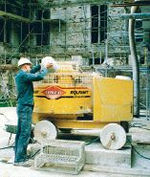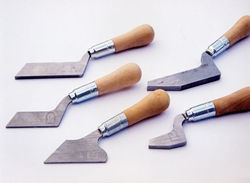Tools of the Trade
Jonathan Taylor
 |
|
| A selection of 19th and early 20th century pointing irons and a quirk (top right) at the Bursledon Brickworks Conservation Centre. Quirks are used for raking out. |
It is astonishing how few of the building contractors who work with historic buildings have the expertise required to work with lime mortars. The contractors and specialist craftsmen included on this website represent only a fraction of the industry, and most building contractors employed to work on old and historic buildings are unqualified to work in conservation. Despite the growing number of excellent information resources, coverage of the subject on radio and TV, tireless promotion by bodies such as SPAB, and the availability of excellent training, few contractors are even aware of the potential damage caused to traditionally-built structures by Portland cement-rich mortars and modern working practices.
The problem with modern Portland cement mortars is that they are much less flexible and porous than traditional lime-based mortars. A modern masonry wall is therefore relatively rigid and where large areas of brick or stone are required, special expansion joints have to be incorporated to allow for thermal expansion. A traditional masonry wall is more flexible, the movement being absorbed by the mortar itself, and there is no need for special expansion joints. Problems often occur where an old wall requires repointing. This is necessary where the exposed mortar has been eroded by the weather or where its cohesion has been lost and it is crumbling. It involves raking or hacking out areas of failed mortar to a certain depth and refilling with fresh mortar. If a non-specialist contractor is employed, the wall will almost invariably be repointed using a hard mortar of sand and cement. The result is that the once-flexible wall is now rigidly bound at its face only, introducing considerable stress on a thin layer of stone or brick. If the mortar is stronger than the stone or brick, the face of the stone or brick will eventually break up under normal environmental pressures.
The arguments in favour of using lime are compelling. However, the skills required for the use of lime, particularly where the repair of old masonry is concerned, are not the same as those required on most modern building sites. Builders need to take the time to learn new skills and techniques, and to familiarise themselves with a different range of materials and tools.
RAKES, CHISELS AND QUIRKS
Before repointing can
commence, any crumbling mortar must be raked out, leaving areas where
the mortar remains sound. As a very thin layer of mortar might not adhere,
the joints should be cleared of all mortar to a depth that is significantly
greater than its width – BRE guidance for all but the narrowest of joints
is that the depth should be twice as great as the width of the joint.
The skill requirement for raking out should not be underestimated; it is all too easy to remove the edges of stone and bricks. Traditional lime mortars are relatively soft and should be raked out by hand with a sharp instrument. A simple spiked instrument should suffice, although where the mortar is sound it may be necessary to use a sharp chisel or flat bladed quirk. However, if a lime mortar is sound, the question that must be asked is whether it is necessary to remove it. Whatever instrument is chosen, it is most important that it cannot jam in the joint, damaging the arrises. Only its handle may be wider than the narrowest part of the joint.
Portland cement rich mortar can be almost impossible to remove without damaging stone or brick, and the benefits of removing it must be carefully considered against the risks before undertaking this challenge. Power tools may speed up the removal but they can also quickly damage the original masonry, and their use should be avoided. However, where cement is hard and stubborn, and is causing visible damage to the masonry, there may be no alternative. The power tools available include pneumatic chisels and rotary mortar rakers. These tools, used without due care and attention, can result in neat, regular joints of a very different character from the original, by failing to respect irregularities in the joints of the original stone or brickwork. Pneumatic chisels are arguably the safest form of mechanical aid, since they operate in much the same manner as hand tools, but with all these aids, in the wrong hands problems can arise.
 |
|
| A roller pan mortar mixer (Photo: Multi Marque) |
MORTAR MIXERS
All
types of lime mortars perform best if they are correctly batched and thoroughly
worked. The particles of lime are extremely fine and tend to coalesce.
In the past the mix would have been beaten by hand, chopped, mixed and
beaten again. This method is still used for small mixes using a heavy
instrument such as a pickaxe handle, but for larger mixes this is not
practical. The ordinary tilting drum mixer used for cement mortars may
be used, relying largely on gravity and a combination of the paddles and
the friction with the drum, but these mortars must be mixed for twice
as long as their modern cement equivalent. Better results may be achieved
using a heavy duty helical paddle mixer, a pan mixer (in which the mortar
is mixed by rotating paddles) or a traditional roller mixer. The latter,
which is illustrated below, is once again available in the UK (see multi-marque.co.uk).
It is a simple mill with heavy rollers rotating around the drum, continually
kneading and mixing the mortar. The height of the rollers is adjustable
to prevent the aggregate being ground down.
POINTING TROWELS, KEYS AND IRONS
After the masonry has been correctly prepared for re-pointing and the matured mortar has been thoroughly knocked-up to the consistency of glazing putty, it must be pressed firmly into the joint void until it is filled out to the face and feels solid. Mortar spreading out into a thin layer across the facework must be avoided, as its failure will provide an avenue for future water penetration. The jointing tool required to deliver and press in the mortar must be one that fits the relevant joint sizes. Small trowels may be adequate for large joints in rubble stone walls and some types of brickwork, but for fine masonry purpose made jointers or pointing irons should be used.
 |
|
| Selection of traditional pointing irons or ‘jointers’ available from Gerard Lynch | |
 |
|
| A panel of tuck pointing by Gerard Lynch with 3mm black ribbons on red stopping mortar to match the existing |
When the mortar is first introduced it is extremely pliable, but it rapidly becomes much firmer as moisture is drawn out of it by the masonry. It must then be gone over to compact and consolidate it and bring it to the required profile and finish. On certain repair and conservation work this is achieved with a tamping action along the joints using a stiff churn brush, producing an exposed aggregate finish to match existing weathered work. Where a fine finish is required, and particularly with tuck pointing, special jointing tools must be used to achieve the desired precision. This is a highly skilled process.
MORTAR PUMPS
Some
contractors use pumped mortar delivery systems such as Gunpoint. Although
these introduce mortar quickly and efficiently into the joint, opinion
is divided as to whether they really speed up pointing, as the mortar
still has to be compacted firmly by hand. Filling and cleaning the equipment
also adds time, and traditionalists would argue that pumping mortar can
be used to hide poor workmanship. However, it seems generally accepted
that, in the right hands, having mortar delivered through a fine nozzle
into the joint may be useful for some types of re-pointing.
Most
of the tools encountered in conservation will seem familiar to a builder
trained on a modern building site. Sensitive conservation clearly depends
on both knowledge and the application of considerable skill in traditional
techniques. However, perhaps the most important requirement is a cautious
and sympathetic approach. It is this more than anything else that separates
the conservator or craftsman from the ordinary contractor.
Recommended Reading
- John and Nicola Ashurst, Practical Building Conservation Volume 3: Mortars, Plasters and Renders, English Heritage, Gower Technical Press, Aldershot, 1988
- John Ashurst, Mortars, Plasters and Renders in Conservation, EASA, 2nd edition, London, 2002
- G Allen et al, Hydraulic Lime Mortar for Stone, Brick and Block Masonry. Donhead, Shaftesbury, 2003
- Gerard Lynch, Brickwork: History, Technology and Practice, Volumes 1 and 2. Donhead, Shaftesbury, 2000



